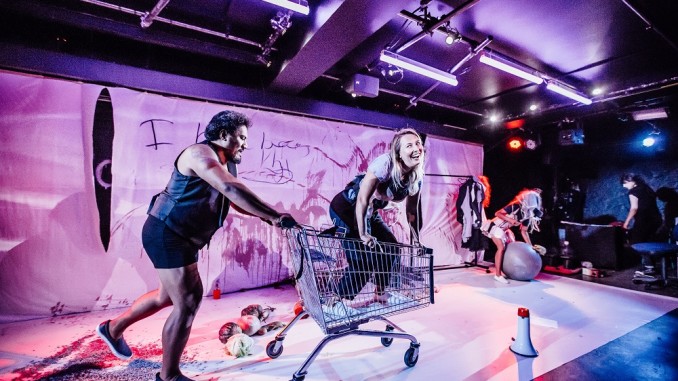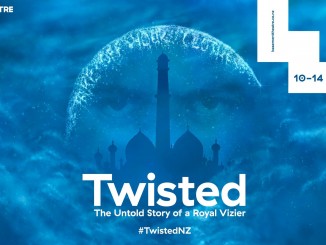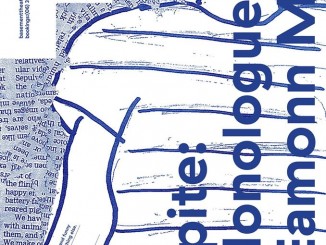
[Auckland Fringe 2017: Auckland Needs You]
As we head into the finals days of the 2017 Auckland Fringe, it’s weird to think that it almost didn’t happen. The Fringe has bumped along biannually since 2009, but after decoupling from Auckland Live support, its long-term survival has been precarious. After funding decisions did not go its way, late last year Fringe director Lydia Zanetti put the feelers out to see if the demand was still there from the artists. Don’t take away our Fringe, they said. Zanetti forged ahead to create this grassroots 2017 Fringe. There is no print program. The poster campaign saved costs by using photo-copies and spray painting text with a stencil. And it’s been absolute brilliant. The Auckland Fringe has been reclaimed, and finding its own unique messy identity.
Sure, there’s an explosion of accessible arts experiences happening all year round in this great city of ours. But the Fringe provides an opportunity to harness it, and also lays down a challenge: what will you show me that I don’t normally get to see? The big international Fringe Festivals, heavy on comedy, have become marketplaces for theatrical product, where work can be on sold and enter the touring circuit (if you don’t bankrupt yourself in the process). The potential of Auckland Fringe is very different: a democratic space for the alternative, where artists and audiences alike can take a punt.
One of the canny things that Zanetti implemented was getting an incredible range of venues interested in hosting Fringe performances, which artists could then match themselves with. One of the biggest stories of this Fringe is how The Basement has forgone its primacy as Fringe central, and it’s about time. There are so many other places you can go to and explore – Garnet Station, Te Pou, Silo Park, The Spreading Tree, Samoa House, Barista Cats…
The Basement are hosting less full-length works this Fringe. Silo Theatre programmed Alice Birch’s Revolt. She Said. Revolt Again over the entire Fringe season, which meant less slots for other companies. It has to be said that the show, though purporting to explore the feminist edge, is still a fairly mainstream show by Basement standards. Revolt is the only play at Auckland Fringe that has also played off-Broadway and been reviewed by the New York Times. It also largely preaches to the converted. As I wrote in my review, it “does not offer comfort, but nor does it get too uncomfortable. Both self-identifying feminists and the Bill Englishes of this country will leave without getting too shaken up.”
Revolt has been win-win for the company and Fringe. The company have become the anchor tenant of The Basement, with Silo audiences becoming aware of the Fringe Festival, and in theory, pollinating other events.
Auckland Live also had another anchor show, Spirit House by Carl Bland, that sat rather oddly within the Fringe program. While it felt like an orphan from Auckland Arts Festival, it was another vote of confidence in the value of the Fringe for established companies.
The Basement reacted to the squeeze caused by Silo’s tenancy by creating the Performance Solon in The Basement Studio space. Transforming the space into an astro-turfed wonderland and bar, each week saw a number of different short theatrical works. I gave up on the Salon after week one. I wanted to see full-length works over sketches, and it was difficult to know what was happening when during the Salon. Works sat awkwardly next to each other – a work in active development from Alice Canton versus a condensed version of Hine. But what made me really uncomfortable were the constant guilt-trips to donate to the artists after every performance. What wasn’t clear before entering was that the $5 I’d paid for my ticket went to The Basement, and not the performers. Thus, the constant hustles for more cash. It might have been more honest to have a higher entry fee which could be split more transparently.
‘Immersive’ theatre and its derivatives have been trendy overseas, and with this Fringe we saw it become common-place in Auckland too. Over the course of two nights during week one I roamed through Rushes, became a romance-enabler in Delivery 17, then took an audio tour through New World Supermarket in Enter the New World.
Allow me to gush about Rushes, created by Malia Johnston, a dance work and so much more. It was my favourite experience of this Fringe. The Lower NZI of the Aotea Centre was turned into a number of different spaces that you could walk through (or spy via a peephole). The audience could travel where they liked, and observe different choreographic creations. Each area had specific ‘rules’, but within that the dancers could improvise moment-to-moment, and the close proximity that we were afforded as audience allowed us to appreciate their effort even more. Rushes was an oasis of beauty, and I found it profoundly moving.
Delivery 17 has the audience play love-courier on behalf of a couple in a long-distance couple. I’m given the number of Tom, a New Zealander in London, and strike up a txt conversation. He has some cutsie things planned for his partner Lavender, who is in Meyers Park where they spent their anniversary together two years ago (seriously, who goes to Meyers Park for their anniversary?). While the show accommodates up to four people per performance, I ended up on this mission solo. While I had some fun txting ‘Tom’ and finding out his story, in lieu of anyone real to actually engage with, helping two fictional characters find happiness became a strange lonely experience, considering the whole thing was actually geared around me!
By virtue of the headphones Binge Culture’s Enter the New World is an intentionally solo affair (though you can sneak smirks of knowingness to fellow participants). Framing the supermarket as a space of colonialism (with the audience as the imperialist invaders), a story emerges between myself and the condiments, with the help of some really slick audio engineering and songs. This was theatre as an intervention against the everyday, in this case drawing attention to our uncritical consumer culture with great originality. When I went on my own supermarket shop a few days later, I couldn’t help but do so with different eyes.
Overall, the Fringe has been a veritable grab-bag of experiences. If Enter the New World didn’t satisfy your theatre meets supermarket cravings, Ben Anderson’s The Last Man on Earth is Trapped in a Supermarket was back to meet them. Infectious, a musical about sexual transmitted disease, was the perfect late-night bender. Nathan Joe thought “Ze”: Queer as Fuck needed to move from the Fringe and into the schools. Tim George compared Tomás Ford’s Chase! to watching a fever dream during a drive-in movie. We’re still a bit shy about embracing the avant-garde, but artists like Julia Croft and Nisha Madhan, who teamed for the triumphant Power Ballad, continue to keep us on our toes. More please.
As Fringe continues to rebuild, and forge greater links with festivals in Wellington and beyond, its need can only grow from here. Congratulations to Fringe champion Lydia Zanetti for making it happen.
Auckland Fringe 2017 closes on 12 March.




Leave a Reply